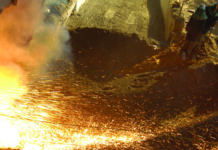
[miningmx.com] – THE dark cloud hanging over the mining industry since the Marikana tragedy is going to be around for a long time – rightly so, because it’s hard to find anything positive coming out of these events.
Other major mining regions, such as Australia and South America, are also subjecting themselves to self-analysis because they so seriously under-estimated the downturn in the Asian industrialisation process, the debt crisis in Europe, and the hammering from which American self-confidence is trying to recover.
How will our mining industry regain its confidence after Marikana?
The instinctive reaction was a predictable repetition of what has been done before when we were trapped in a corner: job lay-offs. This was the case in 1997 when the new Labour Relations Act came into effect. At a high-level meeting of Business Unity South Africa at the time it was said: “Let them have their labour laws – next year we’ll give them hell with lay-offs.’
That’s exactly what they did. In the first two months of 1998, the mining industry threw about 80,000 workers out on the street. The rate of lay-offs slowed down slightly after that, but it continued the rest of that year.
Today unemployment and the accompanying social ills have increased so much that only evil mining chiefs now dare make labour cuts before every other possible alternative has been considered and looked at.
Mechanisation and job cuts
But the damage done with Marikana means that our mines will definitely make more labour cuts in the next quarter or two.
Mechanisation is another old “solution’ that is now gaining ground again. This is a false way of distracting attention if there ever was one. In the junk yards at virtually every one of the country’s most famous gold shafts, and platinum shafts nowadays too, there are thousands of tons of steel exposed to the wind and the weather – machines bought for billions for “mechanisation’, but removed a year or two later and dumped as scrap because mechanisation causes a shaft’s production to drop drastically.
Two of the latest examples of these expensive experiments are Hossy and Saffy, Lonmin’s two largest shafts just a stone’s throw from Marikana. And believe me, this is an expensive way of learning.
The geology in our underground mines, with just one or two exceptions, is simply not suitable for mechanisation. This has been proved over and over.
The solution does not lie in fewer workers.
Before we seek answers, we need to know exactly why those three or four thousand mineworkers brutally murdered two mine security officials and a policeman in a flood of rage. Why did they then entrench themselves for days on the rocks behind Lonmin’s Wonderkop hostel and why were they willing to defend their position with pangas and knives against automatic gunfire and armoured vehicles?
Debt spiral
The research by the Bureau for Economic Research and MBD Credit Solutions announced last week definitely gives much of the answer. This shows for the first time in astounding detail to what extent people in the income group of underground machine operators and general mineworkers (R60,000 to R150,000 per year) are trapped in a huge debt spiral.
The unsecured debt granted to this group increased from R2.3bn in the second quarter of 2009 to a staggering R8.4bn in the second quarter of this year. The levels of their other debt remained the same.
Professor Carel van Aardt, head of the bureau, and economist Johan van Tonder, a researcher, have also analysed the standard of living of mineworkers on the basis of the advertising industry’s well-known All Media Products Survey (Amps). They found that mineworkers in this income group are living far above their means.
Their standard of living is undoubtedly financed by so-called unsecured debt.
It’s not really unsecured debt. The moneylenders, including at least three of our best-known banks, ensure in various ways that they have access to a mineworker’s wage before he gets hold of the hard cash that he could use to buy a flat-screen TV, a hi-fi, a microwave or a fridge or freezer for his tin shack.
Yes, that’s what rockdrill operators have at home, according to the Amps research.
Moneylenders and mining companies
The moneylenders in many cases have agreements with the mining company – the shaft management or higher level – giving them the right to recover the debt directly from a worker’s wages.
Unconfirmed research suggests that up to 10% of the workers in the Rustenburg platinum district do not get any cash wages – everything is swallowed up by the moneylenders.
The debt situation undoubtedly played a major role in the labour unrest that has hit the mining industry over the past months and has cost the country its credit rating.
It’s easy to say it’s the workers’ fault. The fact of the matter is that more than 85% of them have only had a year or two in high school, and even that is an overestimation of their level of education. They are, in practice, illiterate.
How can anyone expect them to be sophisticated enough to cope with the aggressive marketing of microlenders and their cronies? How could they know that interest rates of “prime times 2.2′, “administrative costs’ and “legal fees’ could easily turn a R1,000 loan into an R11,000 one?
It would have been worth while for Anglo American Platinum (Amplats), whose mines came to a halt for nine weeks in an unprotected wildcat strike, to offer every holder of a collection order on Amplats’s payroll the money due to him without interest or any other charges and so pay the workers’ debts for them.
The strikes were a leveraging opportunity to enforce such a settlement. If the creditors refused this offer, the worker could be fired because he was taking part in an unprotected strike. That would mean that the creditor would also lose the security of a collection order for the debt and would probably get nothing back.
Better than these increases
This could easily have resulted in Amplats’s workers being financially better off than with the unrealistic increases they demanded during the strike and did not get.
The fact is that the mines and the Government should have ensured that this debt spiral did not develop.
It should be illegal to give a creditor access to the payroll of people in this income group and with this level of education.
South Africa’s mining industry must accept the realities of the labour force in the industry and must manage it. It’s their responsibility to their companies and shareholders.
Instead, they have fed unsophisticated rural workers from the Eastern Cape coastal regions and the Lesotho Highlands to the bloodsuckers and leeches in Rustenburg.
Now we are all paying a high price for it.











